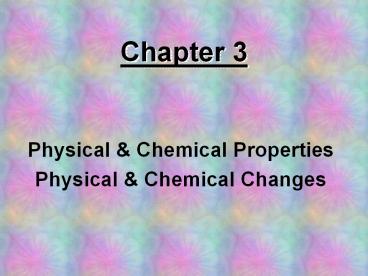Physical - PowerPoint PPT Presentation
1 / 20
Title:
Physical
Description:
Chapter 3 Physical & Chemical Properties Physical & Chemical Changes Physical Properties Characteristics of a substance that can be observed without changing the ... – PowerPoint PPT presentation
Number of Views:130
Avg rating:3.0/5.0
Title: Physical
1
Chapter 3
- Physical Chemical Properties
- Physical Chemical Changes
2
Physical Properties
- Characteristics of a substance that can be
observed without changing the identity of the
substance.
Examples include mass, weight, volume, density,
color, shape, hardness, texture
3
Physical Changes
- when only the form of a substance changes
- example change in phase like solid ice to
liquid water
4
Chemical Properties
- Properties that describe how a substance changes
into new substances
- Examples include flammability, support for
burning, and the ease with which it combines with
other substances
5
Chemical Changes
- During a chemical change, substances are changed
into different substances. - In other words, the composition of the substance
changes.
6
Physical changes do not change the chemical
composition of the substance
- Chemical changes create new substances that can
not be undone.
7
Evidence of aChemical Change
- Color change
- Odor change
- Energy change
- Formation of a gas or solid
- Not easily reversed
8
Color Changes
- As in the case of autumn leaves, a change in
color is a clue to indicate a chemical change.
9
Color Changes
- Perhaps you have found a half eaten apple that
turns brown. The reason is that a chemical
change has occurred when food spoils.
10
Odor Changes
- It only takes one experience with a rotten egg to
learn that they smell different that fresh eggs. - When eggs food spoil, they undergo a chemical
change.
11
EnergyAbsorbed or Released
- the release or gain of energy by an object
indicates a chemical change
12
Energy is absorbed during
chemical changes
involved in cooking, like baking a cake
13
Energy Released
- Energy can also be released during a chemical
change. - Fireworks release energy in a form of light that
you can see.
14
Reaction of Sodium With Chlorine
Na
Cl
- You can also see that energy is released when in
this movie clip sodium chlorine are combined
with water.
15
Productionof a Solid
- A solid that separates out of solution during a
chemical change is called a precipitate.
16
Productionof a Gas
- The formation of a gas is a clue to chemical
changes. - The bubbles of gas that you observed form when an
antacid is dropped into water is an example.
17
Physical Easily reversed
- After ice melts into liquid water, you can
refreeze it into solid ice if the temperature
drops.
Freezing melting are physical changes
18
Chemical- Not easily reversed
- The substances produced during chemical changes
however cannot easily change back into the
original substances like when you burn wood.
19
Chemical Reactions
- Chemical Changes are also called Chemical
Reactions. - Chemical reactions involve combining different
substances. - The chemical reaction produces a new substance
with new different physical and chemical
properties.
20
Law of Conservation of Mass
- Matter is never destroyed or created in chemical
reactions. - The particles of one substance are rearranged to
form a new substance. - The same of particles that exist before the
reaction exist after the reaction.































